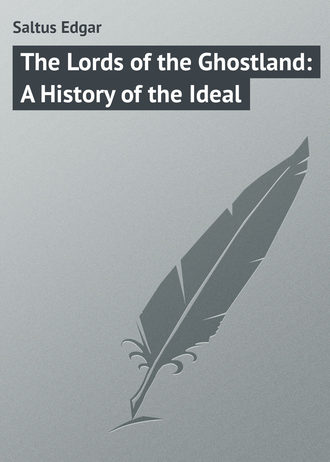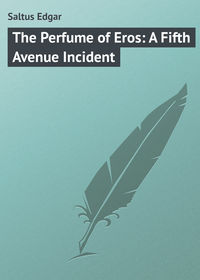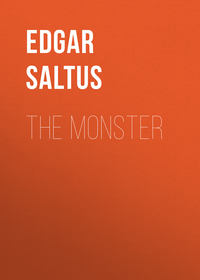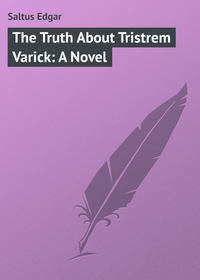 полная версия
полная версияThe Lords of the Ghostland: A History of the Ideal
The doctrine of a trinity, common to almost all antique beliefs, was a blasphemy to the Jews. The belief in immortality, also prevalent, though less general, was to them an abomination. The miracle of divine descent they were perhaps too practical to accept. There was no room in their creed for the dogma of future rewards and punishments, and that, together with other articles of the Christian faith, Egypt's elect professed.
The slaves and mongrels that constituted the bulk of the population were not instructed in these things and would not have understood them if they had been. In Babylonia education was compulsory. In Egypt it was an art, a gift, mysterious in itself, reserved to the few. To the Egyptian, religion consisted in paraded symbols, in avenues of sphinxes, in forests of obelisks, in pharaohs seated colossally before the temple doors, in inscriptions that told indistinguishably of theomorphic men and anthropomorphic gods, and in a belief in the divinity of bulls and hawks.
These latter had their uses. In transformations elsewhere effected, the sacred bull may have become a golden calf, the golden hawk a sacred dove. In Egypt they were otherwise serviceable. The worship of them, of other birds and beasts, of insects and vipers as well, ecclesiastically indorsed, hid the myth of metempsychosis.
Of that the people knew nothing. When they died they ceased to be. Even mummification, usually supposed to have been general, was not for them. Down to an epoch relatively late it was a privilege reserved to priests and princes. When the commonalty were embalmed it was with the opulent design that, in a future existence, they should serve their masters as they had in this. Embalming was a preparation for the Judgment Day. Of that the people knew nothing either. It was even unlawful that concerning it they should be apprised.
In the Louvre is a statue of Ptah-meh, high priest of Memphis. On it are the significant words: "Nothing was hidden from him." A passage of Zosimus states that what was hidden it was illicit to reveal, except, Jamblicus explained, to those whose discretion a long novitiate had assured. To such only was disclosed the secret that life is death in a land of darkness, and death is life in a land of light.
It was because of this that the pharaohs seated themselves colossally before the temple doors. It was because of it that their palaces were inns and their tombs were homes. It was because of it that their sepulchres were built for eternity and the tenements of their souls placed there embalmed. It was because of this that the triumphs of men were inscribed in the halls of the gods. Instead of seeking to be absorbed, it was their own inextinguishable individuality that they endeavoured to assert. Tombs, tenements, triumphs, these all were preparations for the Land of Light.
The land was Alu, the asphodel meadows of the celestial Nile that wound through the Milky Way. To reach it a passport, visé'd by Osiris, sufficed. The first draft of that passport was held to have been written on tablets of alabaster, in letters of lapis lazuli, by an eidolon of Râ, who, known in Egypt as Thoth, elsewhere was Hermes Thrice the Greatest.
At Memphis, Hermes was regarded as representing the personification of divine wisdom, or, more exactly perhaps, the inventive power of the human mind. A little library of forty-two books – which a patricist saw, but not being initiate could not read – was attributed to him.17 The books contained the entire hieratic belief. Fragments that are held to have survived in an extant Greek novel are obviously Egyptian, but as obviously Alexandrine and neo-platonic. In the editio princeps Pheidias is mentioned. Mention of Michel Angelo would have been less anachronistic. The original books are gone, all of them, forever, perhaps, save one, chapters of which are as old as the fourth dynasty and, it may be, are still older. Pyramid texts of the fifth dynasty show that there then existed what to-day is termed The Book of the Dead, a copy of which, put in a mummy's arms, was a talisman for the soul in the Court of Amenti, a passport thence to the Land of Light.
"There is no book like it, man hath not spoken it, earth hath not heard it" – very truthfully it recites of itself. One copy, known as the Louvre Papyrus, presents the Divine Comedy, as primarily conceived and illustrated by an archaic Doré. Text and vignettes display the tribunal where the souls of the dead are judged.
In the foreground is an altar. Adjacent is a figure, half griffon, half chimera, the Beast of Amenti, perhaps too of the Apocalypse. Beyond, an ape poises a pair of scales. For balance is an ostrich feather. Above are the spirits of fate. At the left Osiris is enthroned. From a balcony his assessors lean. At the right is the entrance. There the disembodied, ushered by Truth, appears and, in homages and genuflections, affirms negatively the decalogue; protesting before the Master of Eternity that there is no evil in him; praying the dwellers in Amenti that he may cross the dark way; declaring to each that he has not committed the particular sin over which they preside.
"O Eater of Spirits gone out of the windows of Alu! O Master of the Faces!" he variously calls. "O the One who associates the Splendours! O the Glowing Feet gone out of the Night! I did not lie. I did not kill. I have not been anxious. I did not talk abundantly. I made no one weep. No heart have I harmed."
The assessors listen. "I have not been anxious. I made no one weep. No heart have I harmed." These abstentions, graces now, were virtues then, and so efficacious that they perhaps sufficed, as rightly they should, for absolution.
But while the assessors listen and Osiris looks gravely on, no one accuses. It is conscience in its nakedness, conscience exposed there where all may see it, where for the first time perhaps it truly sees itself, and seeing realizes what there is in it of evil and what of good, it is that which protests.
Still the assessors listen. Orthodoxy on the part of the respondent is to them a minor thing. What they require is that he shall have been merciful to his fellow creatures, true to himself. Only when it is proven that he has done his duty to man, is he permitted to show that he has done his duty to gods.
The appeal continues: "I fed the hungry, clothed the naked, I gave water to them that thirsted. O ye that dwell in Amenti! I am unpolluted, I am pure."
But is it true? The scales decide. The heart of the respondent is weighed. If heavy, out it is cast to pass with him again through life's infernal circles. But, if light as the feather in the balance and therefore equal with truth, it is restored to the body, which then resurrects and, in the bark of the Sun, sails the celestial Nile to Râ and the Land of Light.
That singer gone out of Amenti, actually, like Osiris, rose from the dead. The picture which a papyrus forty centuries old presents, is the dream of a vision that Michel Angelo displayed, a sketch for a papal fresco. Such indeed was the conformity between the underlying conceptions, that, at almost the first monition, Isis, whose veil no mortal had raised, lifted it from her black breast and suckled there the infant Jesus. Then, presently, in temples that had teemed, the silence of the desert brooded. The tide of life retreated, an entire theogony vanished, exorcised, both of them, by the sign of the cross.
At sight of the unimagined emblem, a priesthood who in secret sanctuaries had evolved nearly all but that, flung themselves into crypts beneath, pulled the walls down after them, burying unembalmed the arcana of a creed whose spirit still is immortal.
In Egypt, then, only tombs and necropoles survived. But it is legendary that, in the solitudes of the Thebaïd, dispossessed eidolons of Râ, appearing in the shape of chimeras, terrified anchorites, to whom, with vengeful eyes, they indicated their ruined altars.
IV
BEL-MARDUK
THE inscriptions of Assyrian kings have, many of them, the monotony of hell. Made of boasts and shrieks, they recite the capture and sack of cities; the torrents of blood with which, like wool, the streets were dyed; the flaming pyramids of prisoners; the groans of men impaled; the cries of ravished women.
The inscriptions are not all infernal. Those that relate to Assurbanipal – vulgarly, Sandanapallos, – are even ornate. But Assurbanipal, while probably fiendish and certainly crapulous, was clearly literary besides. From the spoil of sacked cities this bibliofilou took libraries, the myths and epics of creation, sacred texts from Eridu and Ur, volumes in the extinct tongues of Akkad and Sumer, first editions of the Book of God.
These, re-edited in cuneiform and kept conveniently on the second floor of his palace, fell with Nineveh, where, until recently recovered, for millennia they lay. Additionally, from shelves set up in the days of Khammurabi – the Amraphel of Genesis – Nippur has yielded ghostly tablets and Borsippa treasuries of Babylonian ken.
These, the eldest revelations of the divine, are the last that man has deciphered. The altars and people that heard them first, the marble temples, the ivory palaces, the murderous throngs, are dust. The entire civilization from which they came has vanished. Yet, traced with a wooden reed on squares of clay, are flights of little arrows, from which, magically, it all returns. Miraculously with these books a world revives. Fashioned, some of them, at an epoch that in biblical chronology is anterior to man, they tell of creation, of the serpent, the fall and the deluge. At the gates of paradise you see man dying, poisoned by the tree of life. Before Genesis was, already it had been written.
In the Chaldean Book of the Beginnings creation was effected in successive acts. According to the epic of it, humanity's primal home was a paradise where ten impressive persons – the models, it may be, of antediluvian patriarchs – reigned interminably, agreeably also, finally sinfully as well. In punishment a deluge swept them away. From the flood there escaped one man who separated a mythical from an heroic age. In the latter epoch, beings descended from demons built Nineveh and Babylon; organized human existence; invented arithmetic, geometry, astronomy and the calendar; counted the planets; numbered the days of the year, divided them into months and weeks; established the Sabbath; decorated the skies with the signs of the zodiac, instituting, in the interim, colleges of savants and priests. These speculated on the origin of things, attributed it to spontaneous generation, the descent of man to evolution, entertaining the vulgar meanwhile with tales of gods and ghosts.18
The cosmological texts now available were not written then. They are drawn from others that were. But there is a vignette that probably is of that age. It represents a man and a woman stretching their hands to a tree. Behind the woman writhes a snake. The tree, known as the holy cedar of Eridu, the fruit of which stimulated desire, is described in an epic that recites the adventures of Gilgames.
Gilgames was the national hero of Chaldea. The story of his loves with Ishtar is repeated in the Samson and Delilah myth. Ishtar, described in an Assyrian inscription as Our Lady of Girdles, was the original Venus, as Gilgames was perhaps the prototype of Hercules. The legend of his labours is represented on a seal of Sargon of Akkad, a king who ruled fifty-seven hundred years ago.
In the epic, Gilgames, betrayed by Ishtar, tried to find out how not to die. In trying he reached a garden, guarded by cherubim, where the holy cedar was. There he learned that one being only could teach him to be immortal, and that being, Adra-Khasis, had been translated to the Land of the Silver Sky. Adra-Khasis, was the Chaldean Noah. Gilgames sought him and the story of the deluge follows. But with a difference. On the seventh day, Adra-Khasis released from his ark a dove that returned, finally a raven that did not. Then he looked out, and looking, shrieked. Every one had perished.
Noah was less emotional, or, if equally compassionate, the fact is not recited. Apart from that detail and one other, the story of the flood is common to all folklore. Even the Aztecs knew of it. Probably it originated in the matrix of nations which the table-land of Asia was. But only in Chaldean myth, and subsequently in Hebrew legend, was the flood ascribed to sin.
Gilgames' quest, meanwhile, could not have been wholly vain. In an archaic inscription it is stated that the city of Erech was built in olden times by the deified Gilgames.19
How old the olden times may have been is conjectural. Modern science has put the advent of man sixty million years ago. Chaldean chronology is less spacious. But its traditions stretched back a hundred thousand years. The traditions were probably imaginary. Even so, in the morning of the world, already there were ancient cities. There was Nippur, one of whose gods, El Lil, was lord of ghosts. There was Eridu, where Ea was lord of man. There was Ur, where Sin was lord of the moon. There were other divinities. There was Enmesara, lord of the land whence none return, and Makhir, god of dreams.
There were many more like the latter, so many that their sanctuaries made the realm a holy land, but one which, administratively, was an aggregate of principalities that Sargon, nearly six thousand years ago, combined. Ultimately, from sheer age, the empire tottered. It would have fallen had not Khammurabi surged. What Sargon made, Khammurabi solidified. Between their colossal figures two millennia stretch. These giants are distinct. None the less, across the ages they seem to fuse, suggestively, not together, but into another person.
Sargon has descended through time clothed in a little of the poetry which garments nation builders. But the poetry is not a mantle for the imaginary. In the British Museum is a marble ball that he dedicated to a god. Paris has the seal of his librarian.20 Copies of his annals are extant.21 In these it is related that, when a child, his mother put him in a basket of rushes and set him adrift on the Euphrates. Presently he was rescued. Afterward he became a leader of men.
Khammurabi was also a leader. He was a legislator as well. Sargon united principalities, Khammurabi their shrines. From one came the nation, from the other the god. It is in this way that they fuse. To the composite, if it be one, history added a heightening touch.
The Khammurabi legislation came from Bel, who, originally, was a local sun-god of Nippur. There he was regarded as the possessor of the Chaldean Urim and Thummin, the tablets of destiny with which he cast the fates of men. In the mythology of Babylonia these tablets were stolen by the god of storms, who kept them in his thunder fastness. Among the forked flames of the lightning there they were recovered by Bel, who revealed the law to Khammurabi.
The theophany is perhaps similar to that of Sinai. But perhaps, too, it is better attested. A diorite block, found at Susa in 1902, has the law engraved on it. On the summit, a bas-relief displays the god disclosing the statutes to the king.
There are other analogies. Sinai was named after Sin, who, though but a moon-god, was previously held supreme for the reason that, in primitive Babylonia, the lunar year preceded the solar. The sanctuary of the moon-god was Ur, of which Abraham was emir. He was more, perhaps. Sarratu, from which Sarai comes, was the title of the moon-goddess. In Genesis, Sarai is Abraham's wife. Abraham is a derivative of Aburamu, which was one of the moon's many names.22
Among these, one in particular has since been identified with Jahveh. In addition, a clay tablet of the age of Khammurabi, now in the British Museum, has on it:
That flight of arrows, being interpreted, means: Jave ilu, Jahveh is god.23
Other texts show that a title of Bel was Mâsu, a word that letter for letter is the same as the Hebrew Mosheh or Moses.24
It is in this way that Sargon and Khammurabi fuse. Meanwhile the title Mâsu, or hero, was not confined to Bel. It was given also to Marduk, the tutelary god of Babylon, from whom local monotheism proceeded.
That monotheism, in appearance relatively modern, actually was archaic. The Chaldean savants knew of but one really existing god. To them, all others were his emanations. The deus exsuperantissimus was represented by a single stroke of the reed, a sign that in its vagueness left him formless and incommunicable, therefore unworshipable, hence without a temple, unless Bab-ili, Babylon, the Gate of God, may be so construed.
The name of the deity, fastidiously concealed from the vulgar, was, in English, One. Not after, or beneath, or above, but before him, a trinity swung like a screen. From it, for pendant, another trinity dangled. From the latter fell a third. Below these glories were the coruscations of an entire nation of inferior gods. The latter, as well as the former, all of them, were but the fireworks of One. He alone was. The rest, like Makhir, were gods of dream. To the savants, that is; to the magi and seers. To the people the sidereal triads and planetary divinities throned in the Silver Sky augustly real, equally august, and in that celestial equality remained, until Khammurabi gave precedence to Bel, who as Marduk, Bel or Baal Marduk, Lord Marduk, became supreme.
Before Bel, then, the other gods faded as the Elohim did before Jahveh, with the possible difference that there were more to fade – sixty-five thousand, Assurnatsipal, in an inscription, declared. Over that army Bel-Marduk acquired the title, perhaps significant, of Bel-Kissat, Lord of Hosts. Yet it was less as a usurper than as an absorber that the ascension was achieved. Bel but mounted above his former peers and from the superior height drew their attributes to himself. It was sacrilege none the less. As such it alienated the clergy and enraged the plebs. Begun under Khammurabi and completed under Nabonidos, it was the reason why, during the latter's reign, orthodox Babylon received Cyrus not as a foe but a friend.
From the spoliation, meanwhile, no nebulousness resulted. Bel was distinctly anthropomorphic. His earthly plaisance was the Home of the Height, a seven-floored mountain of masonry, a rainbow pyramid of enamelled brick. At the top was a dome. There, in a glittering chamber, on a dazzling couch, he appeared. Elsewhere, in the vermillion recesses of a neighbouring chapel, that winged bulls guarded and frescoed monsters adorned, once a year he also appeared, and, above the mercy seat, on an alabaster throne, sat, or was supposed to sit, contemplating the tablets of destiny, determining when men should die.
To the Greeks, the future lay in the lap of the gods. To the Babylonians the gods alone possessed it, as alone also they possessed the present and the past. They had all time as all men have their day. That day was here and it was brief. Death was a descent to Aralû, the land whence none return, a region of the underworld, called also Shualû, where the departed were nourished on dust. Dust they were and to dust they returned.
Extinction was not a punishment or even a reward, it was a law. Punishment was visited on the transgressor here, as here also the piety of the righteous was rewarded. When death came, just and unjust fared alike. The Aryan and Egyptian belief in immortality had no place in this creed, and consequently it had none either in Israel, where Sheol was a replica of Shualû. To the Semites of Babylonia and Kanaan, the gods alone were immortal, and immortal beings would be gods. Man could not become divine while his deities were still human.
Exceptionally, exceptional beings such as Gilgames and Adra-Khasis might be translated to the land of the Silver Sky, as Elijah was translated to heaven, but otherwise the only mortals that could reach it were kings, for a king, in becoming sovereign, became, ipso facto, celestial. As such, ages later, Alexander had himself worshipped, and it was in imitation of his apotheosis that the subsequent Cæsars declared themselves gods. Yet precisely as the latter were man-made deities, so the Babylonian Baalim were very similar to human kings.
For their hunger was cream, oil, dates, the flesh of ewe lambs. For their nostrils was the perfume of prayers and of psalms; for their passions the virginity of girls. Originally the first born of men were also given them, but while, with higher culture, that sacrifice was abolished, the sacred harlotry, over which Ishtar presided, remained. Judaism omitted to incorporate that, but in Kanaan, which Babylonia profoundly influenced, it was general and, though reviled by Israel, was tempting even, and perhaps particularly, to Solomon.25
The latter's temple was similar to Bel's, from which the Hebraic ritual, terms of the Law, the Torah itself, may have proceeded, as, it may be, the Sabbath did also. On a tablet recovered from the library of Assurbanipal it is written: "The seventh day is a fast day, a lucky day, a sabbatuv" – literally, a day of rest for the heart.26
In Aralû that day never ceased; the dead there, buried, Herodotos said, in honey, were unresurrectably dead, dead to the earth, dead to the Silver Sky. Yet though that was an article of faith, through a paradox profoundly poetic, there was a belief equally general, in ghosts, in hobgoblins, in men with the faces of ravens, in others with the bodies of scorpions, and in the post-mortem persistence of girls that died pure.
These latter, in searching for someone whom they might seduce, must have afterward wandered into the presence of St. Anthony. Perhaps, too, it was they who, as succubi, emotionalized the dreams of monks. Yet, in view of Ishtar, they could not have been very numerous in Babylon where, however, they had a queen, Lilît, the Lilith of the Talmud, Adam's vampire wife, who conceived with him shapes of sin. In these also the Babylonians believed, and naïvely they represented them in forms so revolting that the sight of their own image alarmed them away.
From these shapes or, more exactly, from sin itself, it was very properly held that all diseases came. Medicine consequently was a branch of religion. The physician was a priest. He asked the patient: Have you shed your neighbour's blood? Have you approached your neighbour's wife? Have you stolen your neighbour's garment? Or is it that you have failed to clothe the naked? According to the responses he prescribed.27
But the priest who was a physician was also a wizard. He peeped and muttered, or, more subtly, provided enchanted philters in which simples had been dissolved. These devices failing, there was a series of incantations, the Ritual of the Whispered Charm, in which the most potent conjuration was the incommunicable name. To that all things yielded, even the gods.28 But like the Shem of the Jews, it was probably never wholly uttered, because, save to the magi, not wholly known. In the formulæ of the necromancers it is omitted, though in practice it may have been pronounced.
Even that is doubtful. A knowledge of it conferred powers similar to those that have been attributed to the Christ, and which the Sadducees ascribed to his knowledge of the tetragrammation. A knowledge of the Babylonian Shem was as potent. It served not only men but gods. Ishtar, for purposes of her own, wanted to get into Aralû. In the recovered epic of her descent, imperiously she demanded entrance:
Porter, open thy door.Open thy door that I may enter.If thou dost not open thy door,I will attack it, I will break down the bars,I will cause the dead to rise and devour the living.29Ishtar was admitted. But Aralû was the land whence none return. Once in, she could not get out until, ultimately, the incommunicable name was uttered. The epic says that, in the interim, there was on earth neither love nor loving. In possible connection with which incantations have been found, deprecating "the consecrated harlots with rebellious hearts that have abandoned the holy places."30
In addition to the Ritual of the Whispered Charm, there was the Illumination of Bel, an encyclopædia of astrology in seventy-two volumes which the suburban library of Borsippa contained. During the captivity many Jews must have gone there. In the large light halls they were free to read whatever they liked, religion, history, science, the romance of all three. The books, catalogued and numbered, were ranged on shelves. One had but to ask. The service was gratis.











